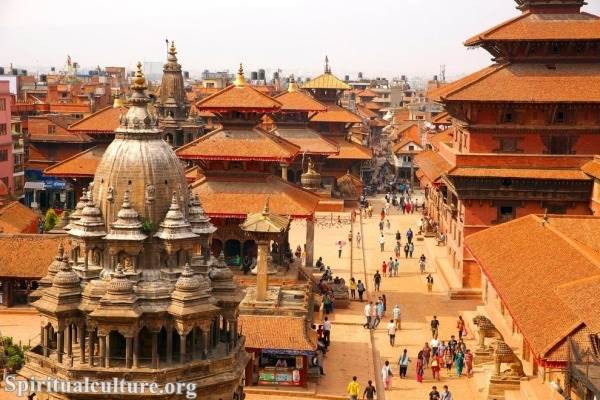The United Kingdom is a nation uniquely defined by its layered history, offering a staggering concentration of sites that bear witness to millennia of human endeavor, from the Neolithic revolution to the age of monarchy and global influence. At Spiritual Culture, we believe the true measure of a historical site is not merely its age or size, but the depth of its cultural and spiritual resonance—the way it continues to shape collective identity and inspire awe today, in November 2025.
This guide moves beyond simple popularity. We critically assess monuments based on their documented spiritual influence, sustained historical significance, and their status as centers of pilgrimage or belief, grounded in the latest verifiable cultural and archaeological data. The sites selected here are the foundational pillars of British heritage, each offering profound lessons in human continuity, architectural genius, and the enduring quest for meaning.
The ranking reflects a comparative analysis of their historical epochs, spiritual purpose (whether pagan, early Christian, or royal-ecclesiastical), and their formal recognition as World Heritage Sites, which underscores their “Outstanding Universal Value” to humanity. Our goal is to illuminate the deeper, often sacred, meaning preserved within these stone and mortar guardians of the past.
Table of the Top 10 World Heritage Sites with the Greatest Spiritual and Cultural Influence
| Rank | Historical Site | Location | Primary Era / Date | UNESCO Status | Spiritual Significance |
|---|---|---|---|---|---|
| 1 | Stonehenge, Avebury and Associated Sites | Wiltshire, England | Neolithic & Bronze Age (c. 3700-1600 BCE) | World Heritage Site | Prehistoric solar/lunar observatory, largest Neolithic cemetery/ritual centre. |
| 2 | Canterbury Cathedral, St Augustine’s Abbey, & St Martin’s Church | Kent, England | Anglo-Saxon / Medieval (Founded 597 CE) | World Heritage Site | Seat of the Anglican Communion, major medieval pilgrimage site (Thomas Becket). |
| 3 | Palace of Westminster and Westminster Abbey | London, England | Norman / Gothic (Since 1066 CE) | World Heritage Site | Coronation and burial site of monarchs, nexus of state and church power. |
| 4 | Durham Castle and Cathedral | Durham, England | Norman (Founded 1093 CE) | World Heritage Site | Finest example of Norman architecture, resting place of St Cuthbert and Bede. |
| 5 | The Tower of London | London, England | Norman (Founded 1078 CE) | World Heritage Site | Symbol of royal power, prison, execution site, and home of the Crown Jewels. |
| 6 | Hadrian’s Wall | Northern England | Roman (Started 122 CE) | World Heritage Site | Northern frontier of the Roman Empire, a symbol of military and cultural demarcation. |
| 7 | Heart of Neolithic Orkney | Orkney Islands, Scotland | Neolithic (c. 3100 BCE) | World Heritage Site | Remarkable Neolithic ceremonial and domestic complex (Skara Brae, Maeshowe). |
| 8 | Fountains Abbey and Studley Royal Water Garden | North Yorkshire, England | Medieval (Founded 1132 CE) | World Heritage Site | Spectacular Cistercian ruin, reflecting monastic spiritual discipline and power. |
| 9 | Iona Abbey | Isle of Iona, Scotland | Early Christian (Founded 563 CE) | Non-UNESCO (Exceptional Spiritual Value) | Cradle of Christianity in Scotland/Northern Britain, burial place of ancient kings. |
| 10 | City of Bath (Roman Baths / Georgian City) | Bath, England | Roman (Since 60 CE) & Georgian | World Heritage Site | Site of the only natural thermal springs, blending Roman healing cult (Sulis Minerva) with Georgian elegance. |
Top 10. City of Bath (Roman Baths / Georgian City)
The City of Bath, a dual World Heritage Site, perfectly illustrates the continuity of human veneration around natural phenomena. While often celebrated for its stunning Georgian architecture and crescents, its cultural heart lies in the Roman Baths, constructed around Britain’s only natural hot springs. This site was not merely a public amenity but a sacred religious complex dedicated to the local Celtic goddess Sulis, whom the Romans syncretized with their goddess Minerva. The preserved complex stands as a unique testament to a healing cult that transcended cultural boundaries, remaining a vital spa destination in November 2025.

The reason for its inclusion lies in its exceptional testimony to the human value of restoration and wellness, long before modern medicine. The Romans built one of the most sophisticated bathing complexes in their empire here, directly linking physical cleansing with spiritual purification under the watchful eye of Sulis Minerva. The site demonstrates an ancient spiritual practice where the landscape itself—the steam, the mineral water—was seen as a tangible link to the divine and a source of both physical and ritualistic healing.
Bath offers a profound moral lesson on the sacredness of natural resources and the deep-seated human need for sanctuary. The city’s subsequent re-invention in the Georgian era, continuing to draw people seeking health and social renewal, demonstrates an unbroken thread of spiritual and physical pilgrimage over two millennia. This enduring respect for the spring’s life-giving power serves as a reflective lesson on environmental stewardship and the simple grace of natural gifts.
Cultural/Spiritual Highlights:
- Dedicated to the healing goddess Sulis Minerva, reflecting Romano-Celtic syncretism.
- Site of Britain’s only natural hot springs, used continuously for ritualistic and physical healing.
- Thousands of curse tablets (votive offerings) found, illustrating direct plea to the divine.
- The only UK city to be a World Heritage Site for both its Roman and Georgian contributions.
Top 9. Iona Abbey
The small, windswept Isle of Iona, off the coast of Scotland, holds a disproportionately massive place in the spiritual history of the United Kingdom, often referred to as a “cradle of Christianity.” Founded in 563 CE by the Irish missionary St. Columba, the Abbey became the primary monastic centre for the spread of Christianity throughout Scotland and Northern England. Though not a UNESCO site, its exceptional cultural value is recognized globally, and in November 2025, it remains a vibrant centre for pilgrimage and reconciliation, managed by the Iona Community.
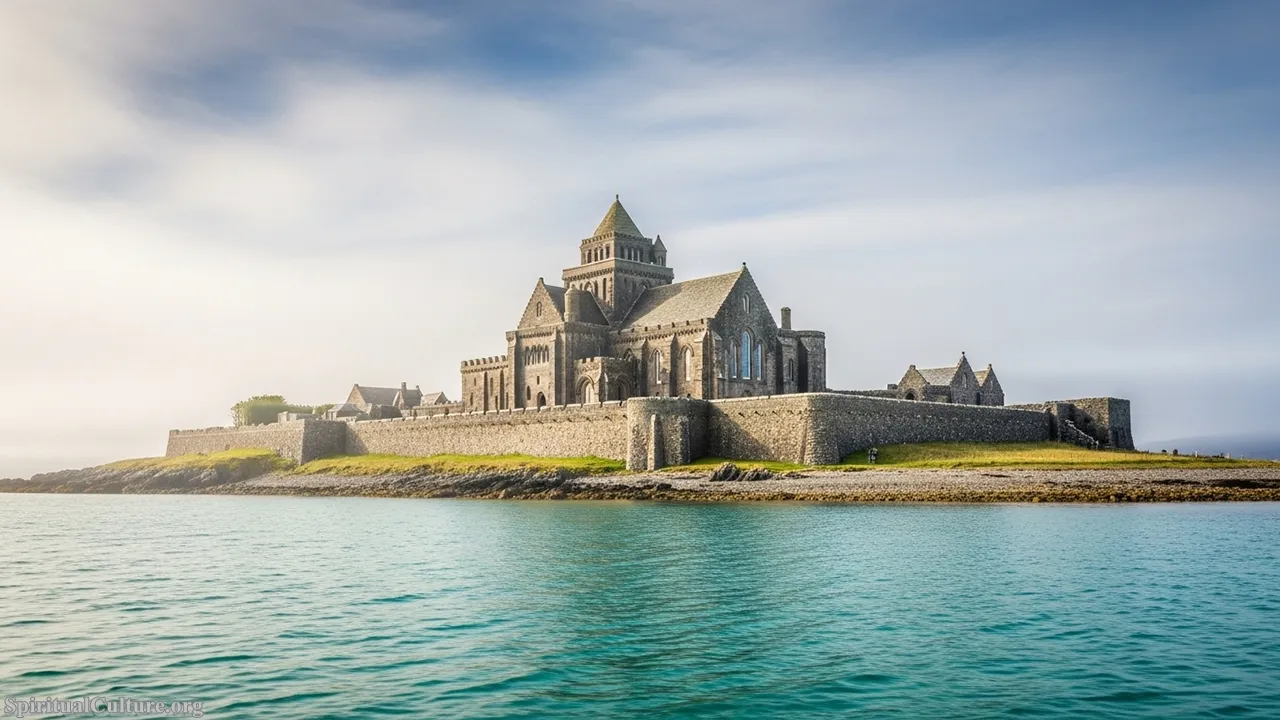
Iona’s ranking is based entirely on its immense spiritual impact as a centre of missionary zeal and Celtic Christianity. It was here that the famous illuminated manuscript, the Book of Kells, is believed to have been started, and it served as the royal burial ground for kings of both Scotland and Ireland. The site represents a unique, isolated spiritual tradition—the Celtic Church—which prioritized scholarship, deep communion with nature, and a distinctive form of monasticism that profoundly shaped the spiritual landscape of the early medieval British Isles.
The preservation of Iona Abbey, now partially restored, provides a powerful reflection on the resilience of faith in the face of isolation and turmoil. It teaches a moral lesson of quiet persistence and the transformative power of a small community committed to a profound spiritual purpose. Visitors leave with a palpable sense of peace, realizing that the greatest cultural movements can originate from the most humble and remote sanctuaries.
Cultural/Spiritual Highlights:
- Founded by St. Columba in 563 CE, spearheading the conversion of Scotland.
- Traditional burial site for over 48 ancient Scottish, Irish, and Norse kings.
- Considered the spiritual and intellectual heart of Celtic Christianity.
- A modern, active centre for Christian ecumenism and reconciliation.
Top 8. Fountains Abbey and Studley Royal Water Garden
Fountains Abbey in North Yorkshire is the most spectacular Cistercian monastic ruin in the United Kingdom, representing the peak of the medieval monastic movement before the Dissolution of the Monasteries in the 16th century. Founded in 1132, the ruins showcase an almost complete Cistercian complex, set within the breathtaking 18th-century Studley Royal Water Garden. Its current status in November 2025 is a World Heritage Site, celebrated for its architectural significance and unique integration into the landscape.
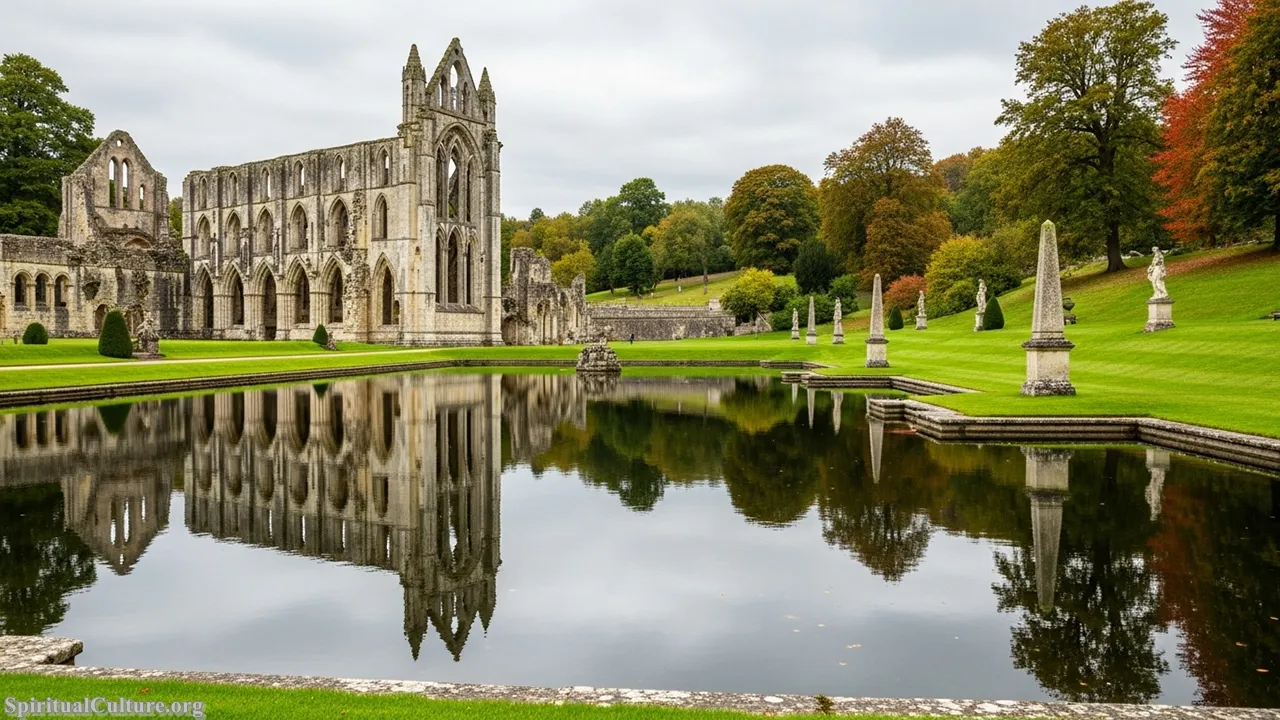
The abbey earns its high ranking for vividly illustrating the spiritual and economic power of the Cistercian order. This was not just a place of prayer; it was an industrial powerhouse, built on a severe, disciplined spiritual rule that saw manual labour as a form of devotion. The grandeur of the ruins speaks to the wealth generated by wool trade and farming, all in service of a life dedicated to God. The austerity of the early Gothic architecture reflects the Cistercian commitment to simplicity and rejection of excessive ornamentation, making the spiritual focus paramount.
The site serves as a poignant reflection on the transient nature of earthly power and the profound preservation value found in intentional ruin. The juxtaposition with the later, man-made Georgian water garden provides a moral lesson on the different ways humanity seeks to capture divine beauty—through severe religious architecture and through romantic, idealized landscapes. It celebrates the enduring human impulse to create spaces that transcend the mundane.
Cultural/Spiritual Highlights:
- The largest and most complete Cistercian abbey ruin in the UK.
- Exemplifies the Cistercian spiritual ideal of simplicity, self-sufficiency, and discipline.
- A UNESCO World Heritage Site since 1986, recognized for its cultural landscape.
- Its lay brothers’ quarters are the finest surviving example in Europe.
Top 7. Heart of Neolithic Orkney
Located on the remote Orkney Islands of Scotland, the Heart of Neolithic Orkney encompasses a group of major 5,000-year-old monuments that collectively stand as a World Heritage Site. These include the village of Skara Brae (the most complete Neolithic village in Europe), the ceremonial Stone Circles of Stenness and Brodgar, and the chambered tomb of Maeshowe. In November 2025, these sites offer an unparalleled window into the culture and spirituality of Britain’s prehistoric farming communities, predating Stonehenge and the Egyptian pyramids.
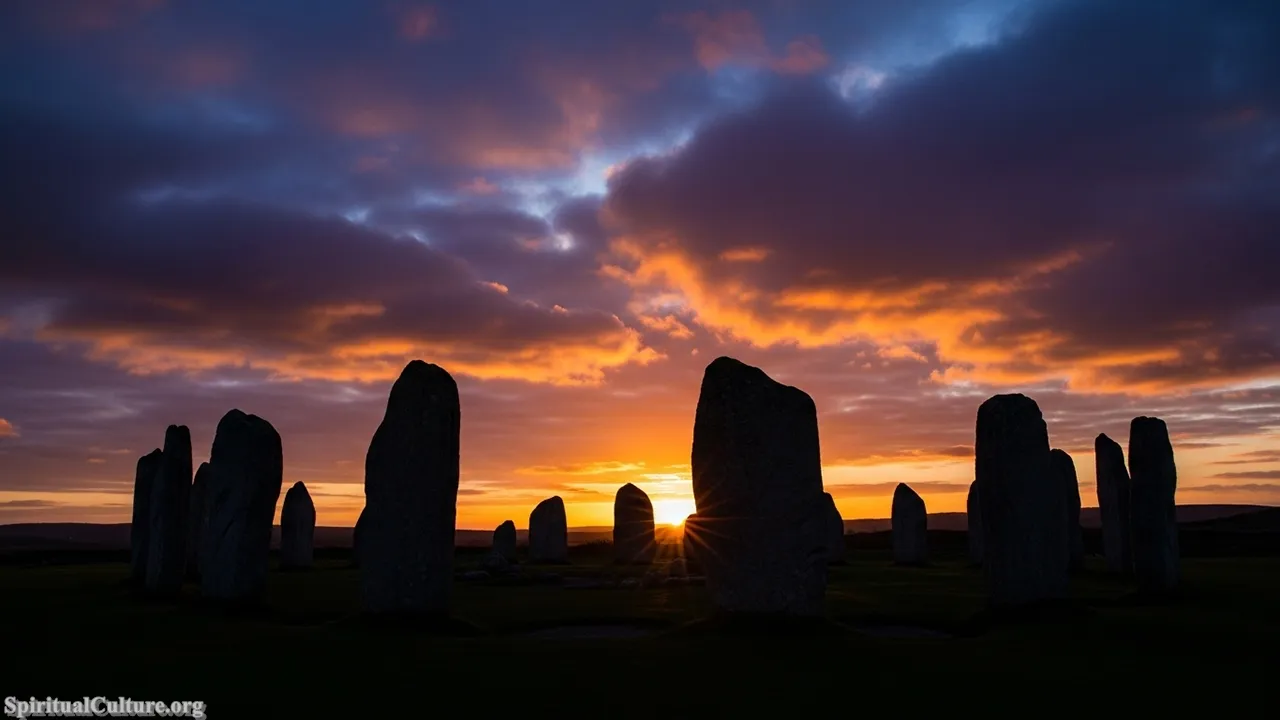
The significance of Orkney is its unique ability to bring the Neolithic spiritual world into sharp focus. Unlike many sites that are merely fragments, Orkney provides a complete picture of life, ritual, and death. The massive stone circles and the monumental passage grave of Maeshowe, aligned to the winter solstice, testify to a sophisticated understanding of cosmology and a powerful ancestor cult. This site is a crucial benchmark for understanding the spiritual impact of the transition from hunter-gatherer to agrarian societies in the UK.
The preservation of Skara Brae, frozen in time by sand, offers a unique moral lesson on the intimacy of ancient life and the deep connections its people had with their landscape and the cyclical nature of time. It compels us to reflect on the immense spiritual investment these early communities made in their sacred landscapes, reminding us that the human search for cosmic order is a continuum that started at the very dawn of settled life.
Cultural/Spiritual Highlights:
- Includes Skara Brae, Europe’s most intact Neolithic village (c. 3100 BCE).
- Maeshowe passage grave is aligned to capture the light of the winter solstice sunset.
- Ring of Brodgar is one of the largest and most dramatically sited stone circles in the UK.
- Provides the most comprehensive insight into Neolithic cosmology and ritual in Northern Europe.
Top 6. Hadrian’s Wall
Stretching 73 miles across the rugged landscape of Northern England, Hadrian’s Wall, a World Heritage Site since 1987, is the single most enduring physical testament to the Roman Empire’s presence and influence in Britain. Begun in 122 CE under Emperor Hadrian, it was not merely a military defense but a cultural and spiritual frontier that marked the boundary between the civilized Roman world and the “barbarian” lands of the north. Its massive scale continues to impress visitors in November 2025.
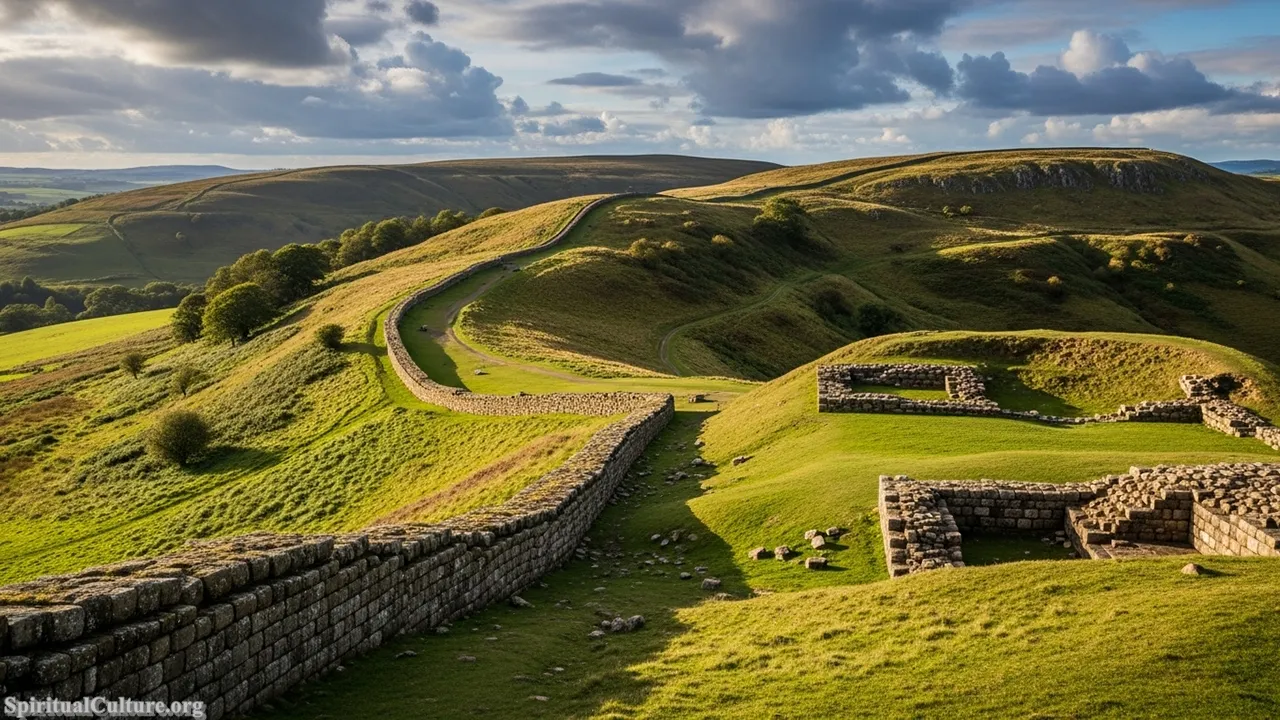
The Wall’s historical and spiritual impact is profound because it symbolizes a fundamental demarcation—the idea of a final, fixed boundary of an empire and a culture. While its purpose was military, its construction required spiritual ceremonies and the creation of cults for the soldiers, including worship of Roman and Eastern gods, often syncretized with local deities. The numerous altars and temples found along its length, such as those dedicated to the Persian god Mithras, reveal the spiritual diversity and devotion of the men stationed on the edge of the known world.
Hadrian’s Wall offers a powerful reflection on the nature of frontiers and the human impulse to define and defend territory. The moral lesson here is one of human resilience and cultural exchange; while built to divide, the Wall eventually became a place of dynamic interaction between Roman and native populations. Its preservation speaks to the enduring historical and archaeological value of this ancient line in the sand, representing two centuries of shifting geopolitical and spiritual boundaries.
Cultural/Spiritual Highlights:
- The longest Roman monument in the world, marking the northern boundary of the empire.
- A site of significant religious syncretism, featuring temples to Mithras and local Celtic deities.
- Part of the UNESCO “Frontiers of the Roman Empire” transnational site.
- A massive physical symbol of cultural and military demarcation for nearly three centuries.
Top 5. The Tower of London
The Tower of London, a UNESCO World Heritage Site situated on the north bank of the River Thames, has stood as an unshakeable symbol of the British monarchy for nearly a millennium since its central White Tower was begun by William the Conqueror in 1078 CE. In November 2025, it remains one of the UK’s most visited sites, acting simultaneously as a former fortress, royal palace, and infamous prison, while currently housing the Crown Jewels.
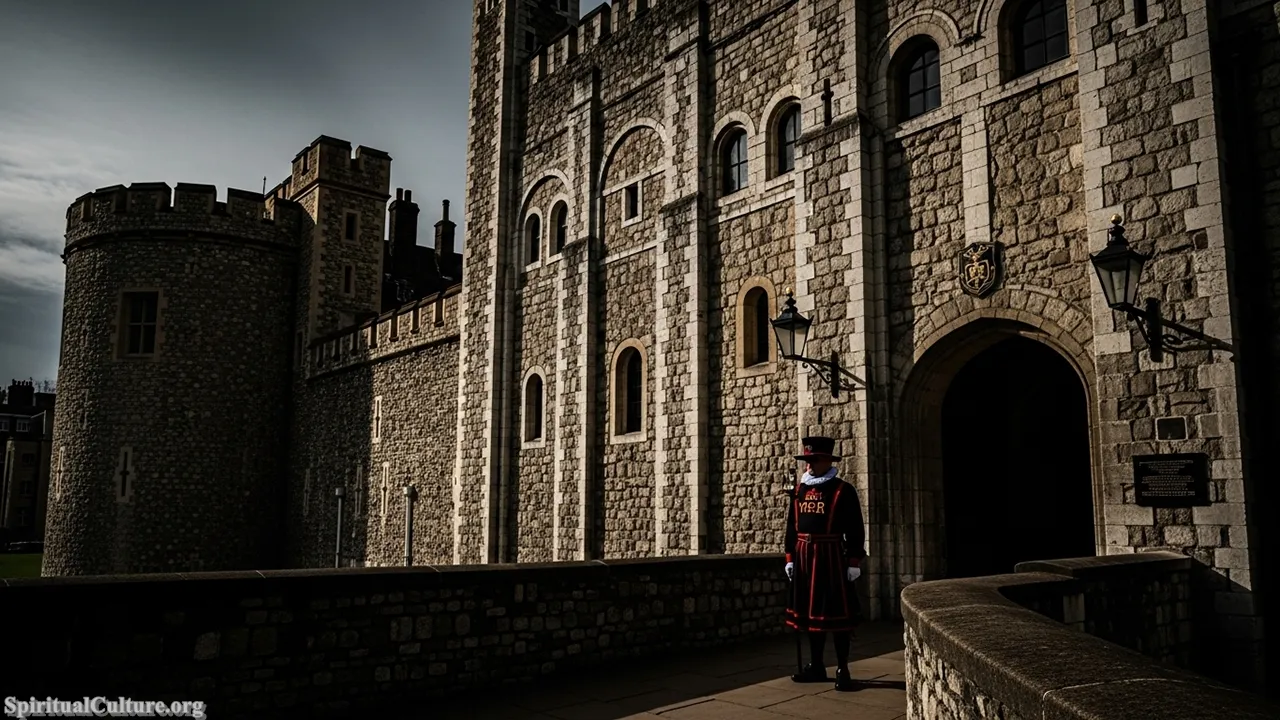
The spiritual impact of the Tower is derived not from worship, but from its profound symbolic power over life and death. It is the repository of the sacred Crown Jewels, tangible objects of power that physically legitimate the monarchy, often used in coronation ceremonies. More darkly, it is a site of political imprisonment and execution—a place where the divine right of kings was violently asserted. The echoes of figures like Anne Boleyn and Thomas More imbue the stone with a powerful, tragic spiritual resonance concerning justice, loyalty, and mortality.
The continued preservation of the Tower, guarded by the ceremonial Yeoman Warders (Beefeaters), serves as a crucial reflection on the nature of political power and human tyranny. The moral lesson it conveys is the constant tension between secular authority and spiritual conscience, a theme dramatically played out within its walls for centuries. It is a monument that compels reflection on the cost of freedom and the solemnity of sovereignty.
Cultural/Spiritual Highlights:
- Holds the Crown Jewels, the physical symbols of the British monarchy’s sacred authority.
- Infamous site of execution and imprisonment, including two Queens of England.
- The central White Tower is one of the most complete 11th-century fortresses in Europe.
- Associated with the legendary ravens, whose departure is said to signal the fall of the kingdom.
Top 4. Durham Castle and Cathedral
Dominating the skyline above the River Wear, the combined UNESCO World Heritage Site of Durham Castle and Cathedral is a truly formidable expression of Norman power and spiritual devotion. Built shortly after the Norman Conquest in the late 11th century, Durham Cathedral is internationally recognized as the largest and finest example of Norman Romanesque architecture, and in November 2025, it continues to function as a vital place of worship and scholarship.
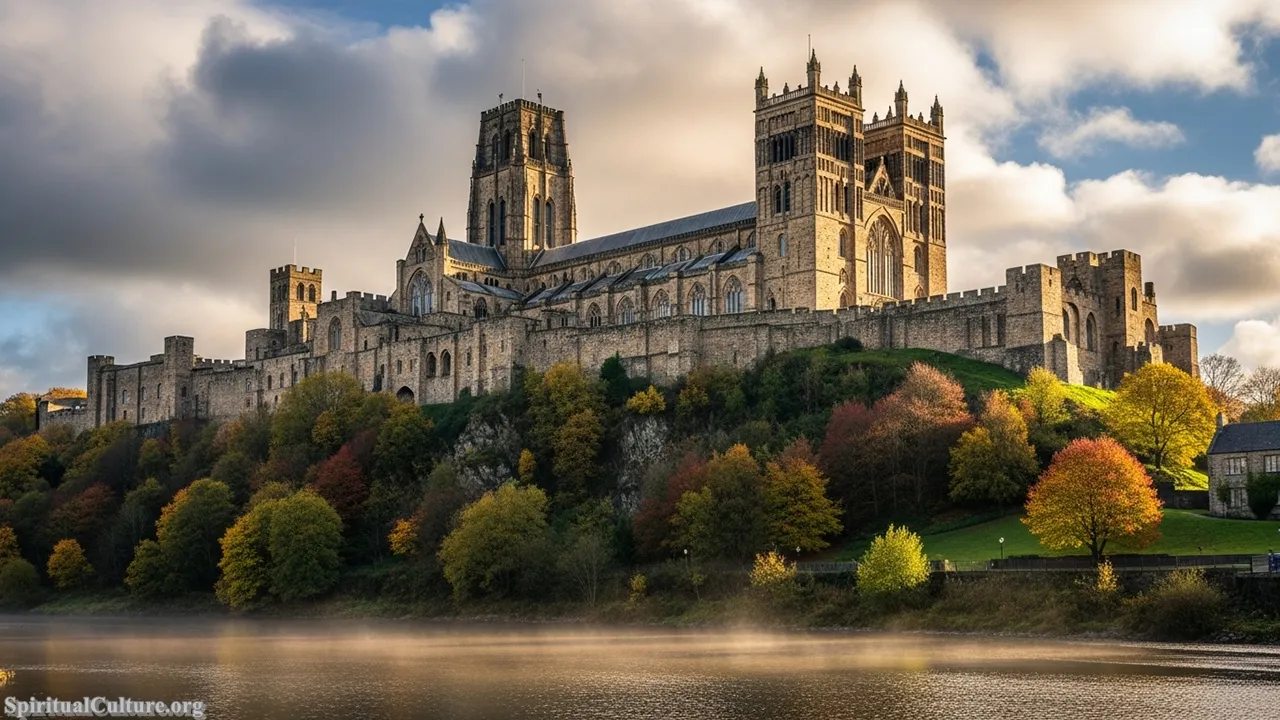
Its elevated ranking is due to its monumental spiritual importance as the final resting place of two pivotal figures of early English Christianity: St Cuthbert (7th-century bishop and saint) and the Venerable Bede (the 8th-century scholar and “Father of English History”). The cathedral was built explicitly to house the shrine of St Cuthbert, turning Durham into a powerful, politically strategic pilgrimage site that effectively functioned as the spiritual capital of the North. The cathedral’s innovative ribbed vaulting also represents a key transition towards the Gothic style, demonstrating its impact on the spiritual architecture of Europe.
Durham offers a profound reflection on the intertwining of religious and military authority, embodied by the Prince-Bishops who ruled the region from the adjacent castle. The moral lesson is the way spiritual relics can inspire monumental acts of architecture and the preservation of intellectual heritage, as seen in the enduring legacy of Bede’s writings. It stands as a powerful testament to the spiritual and political autonomy of the medieval church.
Cultural/Spiritual Highlights:
- Considered the definitive masterpiece of Norman Romanesque architecture.
- Final resting place of the great 7th-century saint, Cuthbert of Lindisfarne.
- The cathedral houses the tomb of the Venerable Bede, the first English historian.
- The innovative stone rib vaulting was a key step in the development of Gothic architecture.
Top 3. Palace of Westminster and Westminster Abbey
Westminster Abbey, alongside the adjacent Palace of Westminster, forms a UNESCO World Heritage Site and the political and spiritual heart of the nation. Since 1066, the Abbey has served as the traditional coronation and burial church for British monarchs, witnessing every coronation since William the Conqueror. In November 2025, the Abbey remains an active Royal Peculiar—a church answerable directly to the monarch—while the Palace houses the UK Parliament.
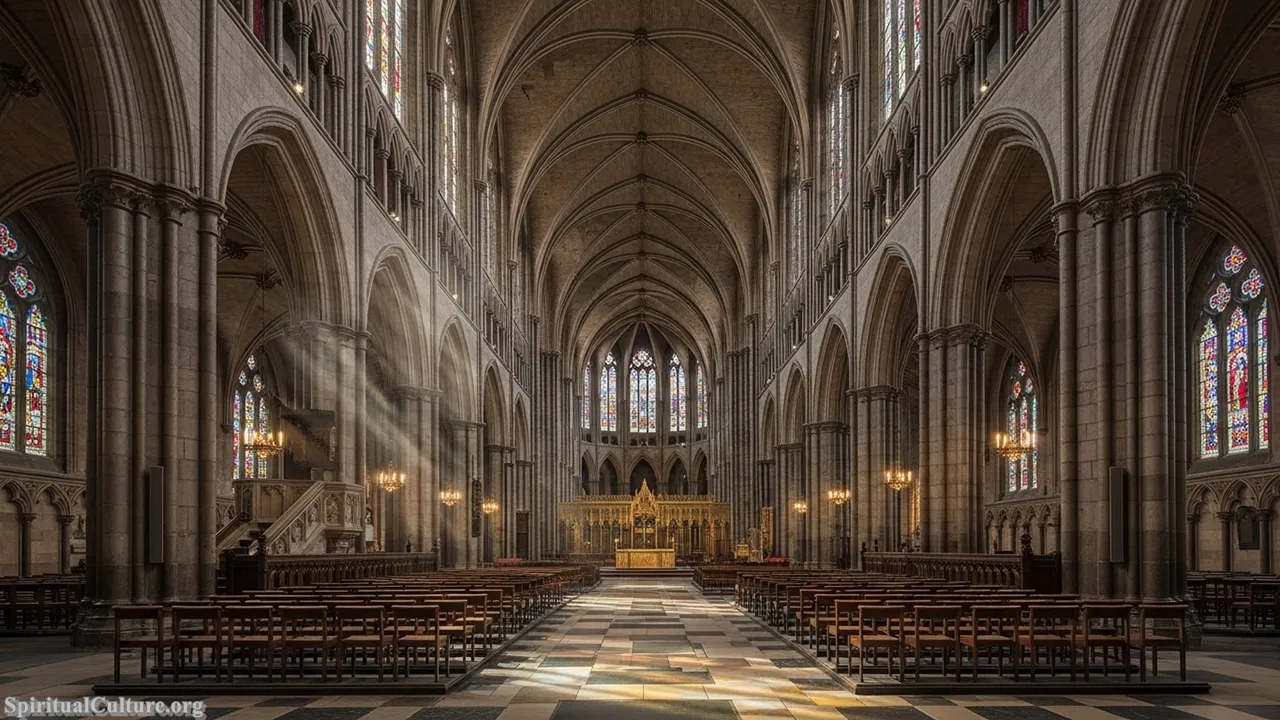
Westminster Abbey’s spiritual impact is unmatched in the UK as the physical site where the bond between the Crown and the Church of England is ritually consecrated. The coronation ceremony itself is a deep spiritual rite, where the monarch is anointed with holy oil, confirming their sacred role. The sheer concentration of national memory, housing the tombs of poets, scientists, and over 30 monarchs, transforms the Abbey into a national shrine—a place where the collective historical soul of the nation is preserved and celebrated.
The continuous, central role of Westminster offers a powerful reflection on the evolution of British identity and the enduring spiritual dimension of governance. The moral lesson is the preservation of continuity; the Abbey acts as a tangible link between a thousand years of history, connecting modern citizens with the figures who shaped their political and religious landscape. It is the living, breathing testament to the sacred nature of public service and legacy.
Cultural/Spiritual Highlights:
- Site of every British coronation since 1066 CE.
- Houses the tombs of over 30 monarchs, including Elizabeth I and Mary Queen of Scots.
- The central focus for the spiritual consecration of the British monarch.
- Poets’ Corner serves as a secular shrine to the nation’s greatest literary figures.
Top 2. Canterbury Cathedral, St Augustine’s Abbey, & St Martin’s Church
Canterbury Cathedral and its associated sites—St Augustine’s Abbey and St Martin’s Church—constitute a World Heritage Site that embodies the foundational history of Christianity in Anglo-Saxon England. St Martin’s is the oldest continuously used parish church in England, dating to the 6th century, while the Cathedral is the mother church of the worldwide Anglican Communion and the seat of the Archbishop of Canterbury. Its spiritual authority is recognized globally in November 2025.

This site’s ranking is exceptionally high due to its foundational role in Christian spiritual life. Its status as the primary pilgrimage destination in medieval England—following the dramatic 1170 martyrdom of Archbishop Thomas Becket—catapulted it into continental fame, immortalized in Chaucer’s Canterbury Tales. The subsequent rebuilding of the Cathedral to accommodate the massive influx of pilgrims created an architectural masterpiece that profoundly influenced Gothic style across Europe, all centred on a deeply personal act of sacrifice and faith.
Canterbury offers a compelling reflection on the immense power of martyrdom to create spiritual inertia that spans centuries. The story of Becket’s defiance against royal power provides a timeless moral lesson on the primacy of spiritual conviction over temporal authority. The ensemble of sites—from the oldest church (St Martin’s) to the centre of the Anglican Communion (the Cathedral)—demonstrates the preservation of a spiritual legacy that has continuously guided the faith of millions for over 1,400 years.
Cultural/Spiritual Highlights:
- Mother church of the worldwide Anglican Communion (85 million adherents).
- Site of the 1170 martyrdom of Thomas Becket, making it a major medieval pilgrimage destination.
- St Martin’s Church is the oldest continuously used parish church in the English-speaking world.
- The eastern end was rebuilt with architectural innovations to manage pilgrim traffic.
Top 1. Stonehenge, Avebury and Associated Sites
The Stonehenge, Avebury and Associated Sites World Heritage Site in Wiltshire is unequivocally the most important historical and spiritual site in the United Kingdom. Dating back nearly 5,000 years, the monumental stone circles of Stonehenge and Avebury represent the zenith of Neolithic and Bronze Age communal and ceremonial life. In November 2025, the enigmatic stones continue to inspire wonder, functioning as an active site for modern-day pagan, Druidic, and astronomical worship, particularly around the solstices.

Stonehenge and its landscape top this list due to their unparalleled, enduring spiritual impact. As one of the world’s most sophisticated prehistoric stone circles, its intentional alignment with the summer and winter solstices confirms its use as a vast, open-air temple and astronomical observatory. Archaeological evidence suggests the area was the largest known cremation cemetery of its time, linking it deeply to ancestor veneration, healing, and the ritualistic passage between life and death. The immense, sustained effort required to move stones from hundreds of miles away speaks volumes about the collective spiritual dedication of the people who built it.
The profound mystery and sheer scale of this ancient monument serve as a universal reflection on the human desire to connect the terrestrial world with the cosmos. It offers a crucial moral lesson: that the oldest, most powerful spiritual impulses—the observation of time, the veneration of ancestors, the quest for healing—are the most persistent. Its preservation is paramount, securing this unique embodiment of humanity’s collective prehistoric heritage for all future generations to ponder the sacred landscape of our distant past.
Cultural/Spiritual Highlights:
- The most architecturally sophisticated prehistoric stone circle in the world (c. 2500 BCE).
- Aligned precisely with the sunrise of the summer solstice and the sunset of the winter solstice.
- Largest known 3rd millennium BCE cremation cemetery in Britain.
- The bluestones were transported over 150 miles from Wales, implying immense ritualistic value.
Conclusion
From the megalithic mysteries of Stonehenge to the medieval majesty of Canterbury Cathedral, the historical sites of the United Kingdom stand as tangible proof of an unbroken spiritual journey. Our analysis, updated for November 2025, confirms that the greatest sites are those that transcend mere historical documentation; they are places where spiritual forces—whether pagan cosmology, Christian devotion, or the assertion of sacred sovereignty—have shaped the physical landscape.
These landmarks are not relics of a dead past, but living centres of cultural inspiration and pilgrimage. At Spiritual Culture, we celebrate these sites as profound sources of wisdom, urging every person to recognize the deeper meaning held within the stones and landscapes. They remind us that the human story is fundamentally a spiritual quest, and that the UK’s heritage offers a wealth of profound, enduring truths.



